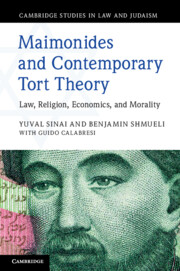Book contents
- Maimonides and Contemporary Tort Theory
- Cambridge Studies in Law and Judaism
- Maimonides and Contemporary Tort Theory
- Copyright page
- Contents
- Figures
- Introduction
- 1 Initial Presentation
- 2 Tort Liability in Maimonides’ Code:
- 3 The Foundations of the Maimonidean Theory:
- 4 The Deontological and Religious Elements of Maimonides’ Tort Theory
- 5 Consequentialist Considerations in the Guide for the Perplexed
- 6 Revisiting the Problematic Texts of the Code in Light of the Guide and Contemporary Scholarship
- 7 Maimonides’ Standard of Care:
- 8 Maimonides as a Pluralistic-Differential Scholar and Contemporary Tort Law Theories:
- 9 Reflections on Maimonides’ Tort Theory
- Index
4 - The Deontological and Religious Elements of Maimonides’ Tort Theory
Published online by Cambridge University Press: 10 August 2020
- Maimonides and Contemporary Tort Theory
- Cambridge Studies in Law and Judaism
- Maimonides and Contemporary Tort Theory
- Copyright page
- Contents
- Figures
- Introduction
- 1 Initial Presentation
- 2 Tort Liability in Maimonides’ Code:
- 3 The Foundations of the Maimonidean Theory:
- 4 The Deontological and Religious Elements of Maimonides’ Tort Theory
- 5 Consequentialist Considerations in the Guide for the Perplexed
- 6 Revisiting the Problematic Texts of the Code in Light of the Guide and Contemporary Scholarship
- 7 Maimonides’ Standard of Care:
- 8 Maimonides as a Pluralistic-Differential Scholar and Contemporary Tort Law Theories:
- 9 Reflections on Maimonides’ Tort Theory
- Index
Summary
We address the deontological, philosophical, pedagogical and religious foundations of Maimonides’ tort theory. Maimonides regards removing the wrong as an important aim of tort law, alongside other aims, which are directed at the meta-aim of the “welfare of the body.” We looked at the similarities and the differences between this aim and the theories of prominent modern corrective justice theories, such as those presented by Weinrib. Maimonides emphasizes educational, punitive, religious (prohibition against causing damage) and social aspects that shape this aim of “removing the wrong” in particular, and tort law in general. Therefore, the application of tort law and the conception of corrective justice is wider according to Maimonides’ approach than according to narrow conceptions of corrective justice that place the emphasis on the correlative framework of the damager/victim. Tort law, according to Maimonides, is designed not only to restore the status quo ante, but to repair the qualities of the damager, to shape him as a person who contributes to a society which dutifully observes the religious precepts and is careful not to cause damage to the property and to the body of another. Moreover, Maimonides incorporates distributive considerations into his theory, particularly on the subject of compensation.
Keywords
- Type
- Chapter
- Information
- Maimonides and Contemporary Tort TheoryLaw, Religion, Economics, and Morality, pp. 138 - 221Publisher: Cambridge University PressPrint publication year: 2020

